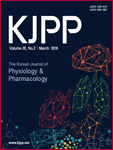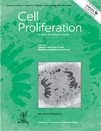
Animal Cells and Systems
Scope & Guideline
Bridging Research and Discovery in Animal Science
Introduction
Aims and Scopes
- Cellular Mechanisms and Signaling Pathways:
Research often delves into the molecular signaling pathways that govern cellular functions, including apoptosis, proliferation, and differentiation, to understand disease mechanisms and identify potential therapeutic targets. - Environmental and Developmental Influences:
Studies investigate how environmental factors, such as toxins or diet, affect cellular behavior and development, particularly in animal models, providing insights into developmental biology and toxicology. - Disease Models and Therapeutics:
The journal features research utilizing various animal models to study disease mechanisms and test therapeutic interventions, particularly in areas such as cancer, neurodegenerative diseases, and metabolic disorders. - Genomic and Transcriptomic Analyses:
There is a strong emphasis on genomic and transcriptomic approaches to understand gene expression patterns and regulatory mechanisms, particularly in response to environmental stresses or during disease progression. - Intercellular Communication and Microenvironment:
Research highlights the role of extracellular vesicles, signaling molecules, and the tumor microenvironment in mediating communication between cells, influencing both normal and pathological processes.
Trending and Emerging
- Neurobiology and Neurodegenerative Diseases:
There is a growing emphasis on understanding the cellular and molecular mechanisms underlying neurodegenerative diseases, with papers focusing on neuroplasticity, signaling pathways, and potential therapeutic interventions. - Microbiome and Host Interactions:
Research exploring the interactions between gut microbiota and host physiology is gaining traction, highlighting the importance of the microbiome in health, disease, and metabolic processes. - Gene Editing and CRISPR Technologies:
The application of CRISPR and other gene-editing technologies is increasingly prevalent, with studies focusing on genetic modifications in animal models to investigate disease mechanisms and therapeutic approaches. - Extracellular Vesicles and Intercellular Signaling:
The role of extracellular vesicles in mediating intercellular communication and their implications in various biological processes, including cancer progression and immune responses, is an emerging focus area. - Circadian Biology and Metabolism:
Research into the interplay between circadian rhythms and metabolic processes is on the rise, reflecting a growing interest in how biological clocks influence health and disease.
Declining or Waning
- Traditional Toxicology Studies:
There has been a noticeable decrease in the publication of studies solely focused on traditional toxicological assessments, as the field shifts towards more integrative approaches that consider multi-organ effects and systemic impacts. - Basic Morphological Studies:
Papers concentrating solely on basic morphological aspects without a clear functional or mechanistic context are becoming less frequent, as the journal trends towards publications that provide deeper biological insights. - In Vitro Cell Culture Studies:
While still relevant, the reliance on simple in vitro models without subsequent validation in vivo is waning, as researchers increasingly seek to demonstrate findings within more complex biological systems.
Similar Journals

CELL BIOLOGY INTERNATIONAL
Illuminating Cellular Processes for a Healthier TomorrowCELL BIOLOGY INTERNATIONAL is a prestigious academic journal dedicated to the rapidly evolving field of cell biology, publishing high-quality research aimed at understanding cellular processes and their implications in various biological contexts. Published by Wiley, this journal has established its relevance with an H-Index that reflects its robust citation impact and a commendable Scopus Rank of #111 out of 285 in the field of Biochemistry, Genetics, and Molecular Biology, positioning it in the 61st percentile. Although it operates under a traditional subscription model, its influential insights are crucial for researchers, professionals, and students alike who are seeking cutting-edge developments in cellular mechanisms and their applications in medicine. The journal spans contributions dating back to 1993, providing a rich archive of knowledge that continues to shape the discourse within the scientific community. With a strong category ranking of Q3 in Cell Biology and Q2 in Medicine (miscellaneous) as of 2023, CELL BIOLOGY INTERNATIONAL stands as a reliable platform for disseminating transformative science in the cellular domain.

KOREAN JOURNAL OF PHYSIOLOGY & PHARMACOLOGY
Illuminating pathways in drug action and physiological understanding.Welcome to the Korean Journal of Physiology & Pharmacology, a pivotal academic platform dedicated to advancing the disciplines of physiology and pharmacology. Published by the esteemed Korean Journal of Physiology & Pharmacology, this journal has been disseminating valuable research findings since its inception in 1997 and continues to be a critical resource for researchers, professionals, and students in South Korea and beyond. With an ISSN of 1226-4512 and E-ISSN of 2093-3827, it offers insights into various aspects of drug action and physiological mechanisms. Although this journal currently does not subscribe to Open Access, it plays a vital role in bridging the gap between experimental and clinical studies, receiving commendations for its quality. In the 2023 Scopus rankings, it is notably positioned in the Q3 quartile for Pharmacology and Q4 for Physiology, reflecting its commitment to excellence. As the journal converges towards its comprehensive coverage in 2024, it remains a cornerstone for those looking to engage deeply with critical developments in these fields.

Advances in Cancer Biology-Metastasis
Exploring the Frontiers of Cancer Biology.Advances in Cancer Biology-Metastasis is an emerging journal published by Elsevier, aimed at advancing our understanding of the complexities of cancer biology, with a specific focus on the mechanisms and pathways related to metastasis. With an E-ISSN of 2667-3940, this journal offers a platform for researchers, professionals, and students in the fields of Cancer Research and Cell Biology to disseminate innovative findings and discuss novel therapeutic approaches. Though currently classified in the Q4 quartile across both Cancer Research and Cell Biology categories, the journal aspires to enhance its impact through rigorous peer review and high-quality publication. Positioned to cover the years from 2021 to 2024, it seeks to bridge gaps in foundational knowledge and promote collaborative research efforts that could pivot the current understanding of cancer metastasis. Researchers are encouraged to take advantage of this platform to advocate for advancements in cancer biology, making significant contributions that can influence both academic and clinical practices.

JOURNAL OF CELLULAR PHYSIOLOGY
Advancing the Frontiers of Cellular KnowledgeJOURNAL OF CELLULAR PHYSIOLOGY, published by Wiley, is a leading peer-reviewed journal that has been at the forefront of cellular research since its inception in 1945. With its prestigious Q1 and Q2 rankings in the fields of Clinical Biochemistry and Cell Biology, this journal is highly regarded within the scientific community, reflecting its significant impact factor and rigorous peer-review process. Addressing the intricacies of cell function and physiology, it serves as a crucial resource for researchers, professionals, and students dedicated to advancing knowledge in the life sciences. The journal publishes cutting-edge research articles, integral reviews, and significant findings that bridge basic biology and clinical applications, ensuring access to high-quality scholarly content that informs current practices and future research directions. Although not open access, the journal maintains a rich archive of studies, making it an essential reference point for those invested in the health and biological sciences.

MOLECULAR AND CELLULAR BIOLOGY
Bridging Knowledge Gaps in Molecular BiologyMOLECULAR AND CELLULAR BIOLOGY, published by TAYLOR & FRANCIS INC, stands as a preeminent platform for researchers, professionals, and students engaged in the dynamic field of molecular and cellular biology. Established in 1981 and ongoing into 2024, the journal features cutting-edge research that spans across vital sub-disciplines, garnering a strong impact in its contributions to the scientific community. With an impressive Q2 ranking in Cell Biology and Q1 ranking in Molecular Biology for 2023, it consistently publishes high-quality articles that reflect the latest advancements and discoveries within the field. The journal is particularly well-regarded for its rigorous peer-review process and commitment to scientific excellence, making it an invaluable resource for those seeking to deepen their understanding of molecular mechanisms and cellular processes. Although not open access, the journal offers diverse access options for researchers to reach the latest findings. By maintaining a strong focus on biochemistry, genetics, and molecular biology, MOLECULAR AND CELLULAR BIOLOGY remains essential reading for anyone looking to contribute to or stay informed about significant developments within this pivotal area of study.

Physiology and Pharmacology
Fostering collaboration in the realms of physiology and pharmacology.Physiology and Pharmacology is a distinguished open access journal that has been disseminating high-quality research in the fields of physiology and pharmacology since its inception in 1997. Published by the Iranian Society of Physiology & Pharmacology, this journal offers a platform for scholars and practitioners to share innovative findings and advancements that contribute to the understanding of biological systems and drug action. With its ISSN 2476-5236 and E-ISSN 2476-5244, it ensures global reach and accessibility. The journal is positioned in the third quartile for Linguistics and Language and fourth quartile in both Pharmacology and Physiology categories according to Scopus rankings, reflecting a commitment to expanding knowledge within these interdisciplinary domains. Set within the academic landscape of Iran, the journal aims to bridge regional research with the international community, providing valuable insights into physiological processes and pharmacological developments. In light of its open access model, the Physiology and Pharmacology journal plays a crucial role in enhancing the visibility of research outcomes and fostering collaboration among researchers, professionals, and students on a global scale.

CELL PROLIFERATION
Exploring Innovations in Cellular and Molecular BiologyCELL PROLIFERATION, published by Wiley, is a leading open-access journal that has been at the forefront of research since its inception in 1968. With an impact factor that solidifies its position in the Q1 category of both Cell Biology and Medicine (Miscellaneous), this journal serves as a premier platform for disseminating groundbreaking studies in the field of cellular and molecular biology. The journal is renowned for its rigorous peer-review process and comprehensive coverage of topics related to cell growth, division, and differentiation, making it an invaluable resource for researchers, professionals, and students alike. With its notable Scopus ranking of #30 in Biochemistry, Genetics, and Molecular Biology: Cell Biology, and a robust open access model since 2019, CELL PROLIFERATION ensures that cutting-edge research is accessible to a global audience, fostering collaboration and innovation across the scientific community. Located in the United Kingdom, the journal remains committed to enhancing the understanding of cellular processes, thereby influencing developments in medicine and biotechnology.

TRENDS IN CELL BIOLOGY
Transforming Understanding of Cellular ComplexityTRENDS IN CELL BIOLOGY, published by CELL PRESS, is a premier journal in the field of cell biology, recognized for its high-impact contributions since its inception in 1991. As a distinguished member of the Q1 quartile within its category, the journal holds an impressive Scopus ranking of #8 out of 285, placing it in the 97th percentile of the field, which underscores its reputation for excellence. The journal serves as an essential resource for researchers, professionals, and students who are engaged with groundbreaking advancements in biochemistry, genetics, and molecular biology. Although it is not open access, it provides critical insights into the latest trends, reviews, and advancements in cell biology, making it a crucial tool for anyone committed to understanding the complexities of cellular systems. With a focus on innovative and transformative research, TRENDS IN CELL BIOLOGY continues to shape the discourse in cell biology and enhance the scientific community's knowledge.

BIOSCIENCE REPORTS
Driving Progress in Biochemical and Cellular ResearchBIOSCIENCE REPORTS, published by Portland Press Ltd, is a prestigious journal dedicated to advancing the fields of biochemistry, biophysics, cell biology, and molecular biology. Founded in 1981, the journal has established itself as a vital resource for researchers and professionals, boasting a significant impact factor and high rankings within its categories, including Q2 in Biochemistry and Q1 in Biophysics as of 2023. The journal’s commitment to high-quality, peer-reviewed research ensures that it remains an influential platform for the dissemination of cutting-edge scientific findings. While it operates under a traditional subscription model, it offers various access options to accommodate the needs of the scientific community. With ongoing publication through 2024, BIOSCIENCE REPORTS continues to play a crucial role in shaping discussions in the life sciences and fostering innovative research in biology.

CELLULAR SIGNALLING
Illuminating Pathways in Biochemistry and GeneticsCELLULAR SIGNALLING, published by Elsevier Science Inc, is a premier journal within the realm of Cell Biology, boasting an impressive Q2 category ranking as of 2023. With an ISSN of 0898-6568 and an E-ISSN of 1873-3913, the journal has established itself as a critical platform for advancing the understanding of cellular mechanisms and signal transduction pathways since its inception in 1989. Covering a vast array of topics in Biochemistry, Genetics, and Molecular Biology, it ranks notably at 87 out of 285 in the Scopus list, placing it in the 69th percentile among its peers. The journal serves as an invaluable resource for researchers, professionals, and students seeking high-quality, impactful studies that drive forward the field of cellular biology. While it operates under traditional subscription access, its highlights include rigorous peer-reviewed articles, reviews, and insights that continue to shape current scientific discourse.